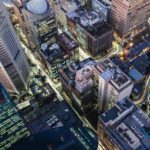Meet your instructors:
University of British Columbia:
– Jonathan Barnett
– Larry Beasley: Distinguished Practice Professor of Planning
What you’ll learn:
- The principles of ecodesign and why it is important as a response to the current disorganized urban growth model
- Ways to adapt to a changing climate, and ways to mitigate climate change locally
- Policies to balance auto and airplane transportation with walking, cycling, transit and high-speed rail
- Ways of designing urban and suburban regulations to make cities more livable and environmentally compatible
- Strategies for designing and managing the public realm, plus Innovative arrangements and processes for implementing ecodesign.
- Length: 6 Weeks
- Effort: 4–5 hours per week
- Price: FREE
Add a Verified Certificate for £74 - Institution: UBCx
- Subject: Environmental Studies
- Level: Introductory
- Language: English
- Course Type: Self-paced on your time
Course Review: Ecodesign for Cities and Suburbs:
A summary
“Ecodesign for Cities and Suburbs” by UBCx is a free and open online course which aims to introduce students to the principles and processes of ecodesign. The course explores how the environmental, social, and economic aspects of cities and suburbs can be designed in response to today’s changing climate. By the end of this course, the student will understand the principles of ecodesign and will be able to apply those principles to example projects.
Course begins by explaining what ecodesign is and why it has gained so much attention in the last years. One of the main lessons of this course is that design is not simply the physical arrangement of buildings and infrastructure but rather the process of creating cities. Furthermore, the city itself is not just a composition of buildings and people but rather a system that requires design and maintenance. The course goes on explaining that “ecodesign considers the economic, social, and environmental sustainability of urban development”.
After the first lesson, students are introduced to the idea of three main goals of ecodesign which are: environmental sustainability, social inclusiveness, and economic prosperity. In order to achieve these goals, three main solutions are highlighted: renewable energy, responsible water, and urban agriculture. The course continues by explaining the importance of urban agriculture in its ability to provide green corridors in the city and the opportunity to reduce the need of energy-intensive transport for the food that cities need to import.
A very interesting lesson of this course is the one where the instructor asks students to analyze and compare various ways of transportation. The instructor highlights the cost and benefit of each one, giving out a very detailed comparison between airplanes, trains, buses and cars. This made very clear for students the static way of thinking and acting of many people who have no idea what they are doing to the environment by simply using their car. This part of the course explains how many of the transportation we are using on a daily basis leads to enormously negative environmental, economic and social consequences to society as a whole.
The main point of this course is to provide students with the genuine picture of the world we are living in. Many people are simply using cheap and poor-quality transportation with no deep thought about the environmental consequences of their actions. On the other side, some of the transportation we use today is very expensive but also very effective, as many of them are replacing conventional ones for the sake of the environment. The course brings up a very interesting subject of air transportation vs high-speed rail which is a long-standing debate in many countries. In the end, it is clearly explained that investing in high-speed rail is much more efficient than investing in new airplanes.
In the next lesson, students get to learn about the public realm in detail. This section is more about managing the public space than designing it, and so details are provided to help students know what to avoid. Good examples are provided as a way to highlight the importance of having good public spaces. The course also brings up the example of the rise of street markets that bring urban life to the streets and how certain cities have used the market as a way to deal with depopulation and revive their districts. Later, students get to learn about the importance of democratic principles in urban design.
A very interesting discussion about the public realm and democracy leads us to the third goal of the course which is economic prosperity. Students get to learn an overview about the history of cities from the Roman Empire to today. A very good lesson about the role of cities in the world of today. Cities and their transport strategies are leading to huge economic benefits but at the same time the social costs are enormous and worsening by the day.
The next lesson provides a very informative debate about the role of architects in society in general. A very good explanation is provided about why architects are so in demand not only for high-end luxurious houses for the rich but for anyone who requires any kind of construction. The economic crisis has become the demand for cheap and unskilled labor and thus architects have become useful again for creating buildings in a cost-effective way while still being of good quality.



